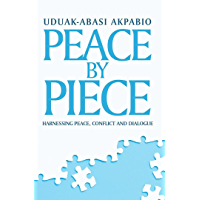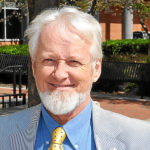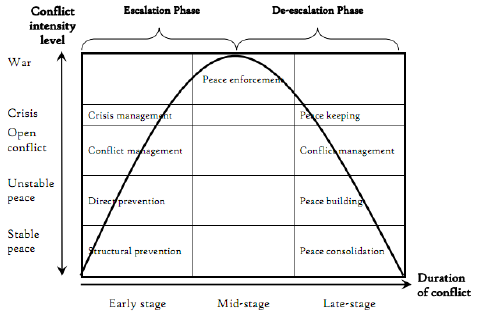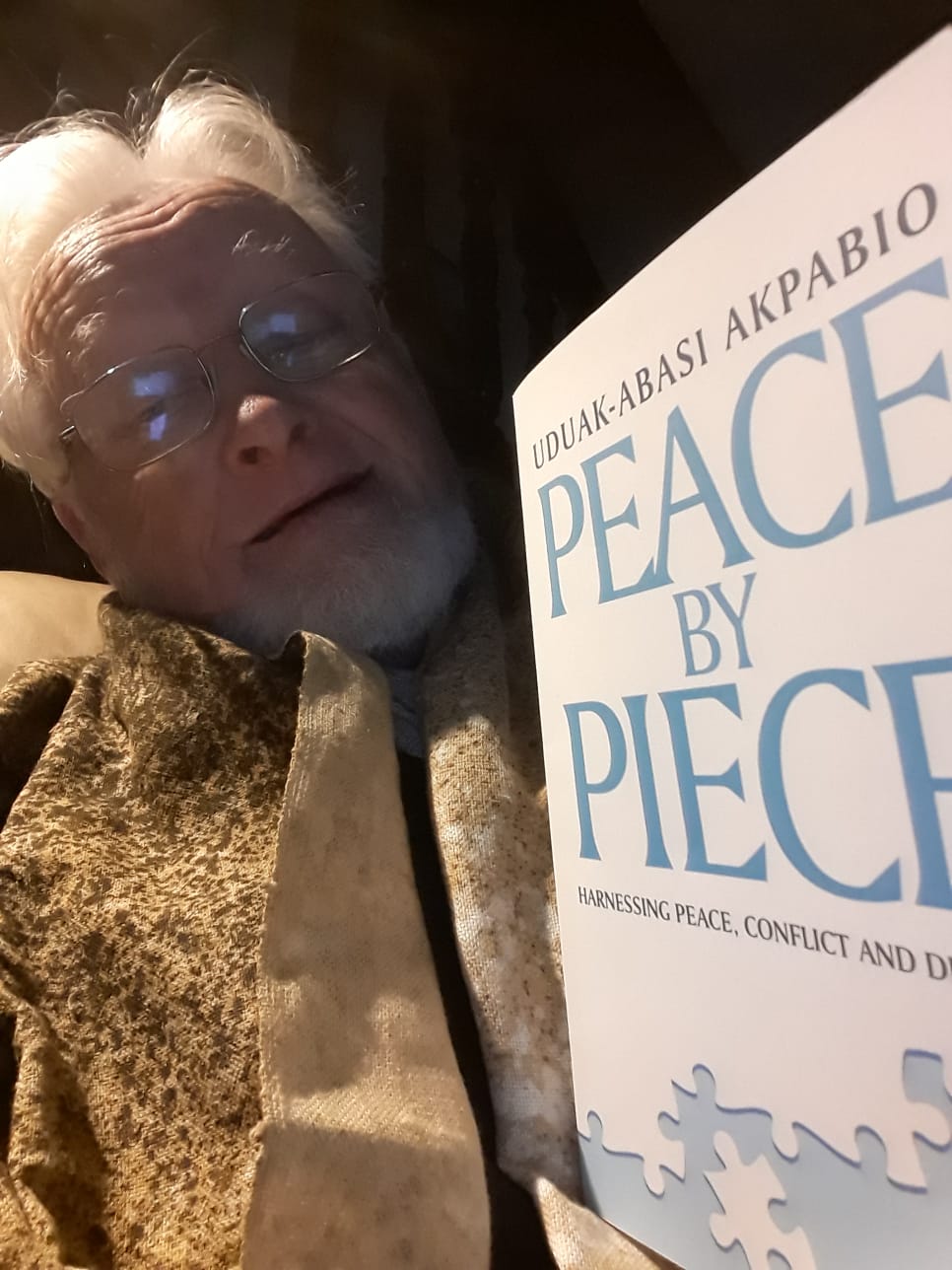Peace by Piece: Harnessing Peace, Conflict and Dialogue
REVIEWS, 19 Jul 2021
Robin Edward Poulton, Ph.D. – TRANSCEND Media Service
Peace by Piece: Harnessing Peace, Conflict and Dialogue, by Uduak-Abasi Akpabio, Amazon, Jun 2021
It takes courage to write a book! As soon as you put your ideas down on paper, they are open to criticism. Especially if they talk peace. Uduak-Abasi Akpabio is a young lady with courage: she has written an excellent book about processes that can broker peace, marrying peace theory with peace practice. Making peace is tough, in a world where vast sums of money fuel the makers and users of weapons. Violence enriches the suppliers of ammunition. Arms and automobile manufacturers, petroleum corporations and security companies all get rich from war. Other people’s misery and deaths make weapon corporations rich.
My peace-making friend, Nigerian General Clément Dayo Olukoju, says:
“In peace building it is not the number of times you fail that matters, but the number of times you are able to overcome disappointments.”
So I will start this review article by warning Uduak-Abasi that she will need determination and patience, as well as courage, in her life of creating peace by piece.
Like General Olukoju, Uduak is a Nigerian graduate of the European Peace University, where she was one of my students. EPU was a radical institution created by allies of Professor Johann Galtung, the Father of Peace Studies, in association with the Austrian Study Centre for Peace and Conflict Resolution (ASPR) founded in 1982 by Dr Gerald Mader in the medieval castle of Schlaining, South Burgerland. Radical because the EPU ran a Master’s program for young and mid-career professionals, using the real-life expertise of peace practitioners to enrich the classroom teaching of classic university professors. Each of us came to deliver courses of one, two or three weeks in our areas of special expertise. Mine were micro-disarmament, terrorism, and how to (sometimes) persuade armed rebel groups to give up their weapons and buy into a peace process: known by the technical acronyms of DDR and SSR: disarmament, demobilization and reintegration, which is a part of Security Sector Reform in a post-conflict situation.
Uduak was one of an exciting and very international cohort of highly-intelligent Master’s students, who came to study peace making and conflict transformation. She writes at the beginning of her book,
“I have always had a passion for facilitating peace and addressing conflicts.” And again: “Peace is not just an end state, but a capacity: and like every capacity, it needs to be built.”
The Galtung theoretical construct for our teaching was “conflict transformation” – a conceptual approach that no other academic institution was promoting. Negotiating cease-fires and truces is not sufficient: unless violent conflicts can be transformed into something different, violence is likely to flare up again. From here come Galtung’s valuable definitions of “negative peace” – where a ceasefire have been declared, physical violence has stopped, but the underlying causes of conflict remain unresolved – and “positive peace” which involves the parties seeking common ground, resolving as far as is possible the problems at the source the conflict: which often involve political exclusion, growing poverty, and hidden forms of institutional or cultural discrimination. The EPU was too radical for Austria’s traditional university system, whose professorial academic hierarchy swallowed it up in 2013.
His helpful, theoretical peace paradigms are explained by Johann Galtung in his 1996 book Peace by Peaceful Means (Oslo: Prio), based on many real-life mediation experiences. These ideas are widely used in classroom teaching. Someone from a purely academic background, however, would not have been able to write the book that Uduak has written, because it draws on her practical experience of conflict transformation.
Uduak-Abasi’s book has three parts:
- Factors, Outcomes and Benefits of Peace: studying common themes in peace and health.
- Review of the Conflict Cycle: a theoretical analysis of conflicts evolving through time.
- Effective Dialogue and Stakeholder Forums: based on Uduak’s field experience in South Sudan, where she acted as a neutral, outside facilitator bringing political parties together in a search for common ground, seeking peace through dialogue, listening and compromise.
- Factors, Outcomes and Benefits of Peace (written in 2015-2017)
Uduak explores the commonalities between seeking health and seeking peace. Using Galtung’s concepts, she shows how health can provide a helpful peace analogy, especially for educational purposes. Peace education = inoculation (p25); Health outcomes = Peace outcomes, emphasising the importance of strong institutions (p23) in both cases. In the same way that a country’s poor health institutions lead to poor health outcomes, so in a similar manner the weakness of justice systems, policing systems, the corruption of the military, the venality of politicians can produce the conditions that alienate citizens, increase poverty and breed violent conflict.
In Africa, the Executive has often corrupted the institutions designed to provide checks and balances: judges are beholden to ministers; the education system is underfunded and under-performing; the legislature is turned into a ‘rubber stamp’ for presidential decrees, and the security forces are transformed into a personal militia protecting the president. Sierra Leone under Siaka Stevens provided a sad-but-perfect example of this process, culminating in the heads of the army and police being incorporated into the Cabinet and becoming political actors.
The weakness of post-colonial institutions across Africa opened the way during the 1960s for military rule. The colonial powers invested in only one institution: Europeans used the security forces to repress the population, and the army was virtually the only strong institution that colonial administrators left behind. It is true that some of the new countries (Mali, Senegal, Nigeria) began life with strong railway unions, teachers’ unions, sometimes mining unions (Zambia, Ghana), but these were insufficient to temper the centralizing power of the Executive. There were also cooperative movements with social and economic influence (Nigeria, Senegal, The Gambia), but they were easily manipulated by governments. Cooperatives were actively suppressed after Mali’s 1968 military coup, seen as a threat to centralized power; while the education system was deliberately starved of resources to weaken potential opposition. The media? Often strong in ideas, most African private media organizations suffered from under-funding, while official government media held sway and often controlled the airways. The church? Churches and mosques have certainly proved resilient in Africa; but divided and politically powerless, church leaders and mosque leaders have been unable to stem the tide of corruption and bad governance.
It is this institutional weakness in Africa that has led me to the conclusion that strengthening Civil Society Organisations (CSOs in in all their complexity, including trade unions, cooperatives, women’s associations, religious leaders and the media) provide the best mechanism for promoting good governance in Africa. Civil Society, as the Second Pillar of the State, provides countervailing powers to central a local governments that may limit abuses, and promote peace – as we outline in our book The Limits of Democracy (Poulton & Tonegutti, Amazon 2020).
Civil society organisations – like African families and village communities – are fundamental building blocks of social capital. Without using the same terminology, Uduak-Abasi herself understands that social capital is an important part of peace building: “peace is a resource to be invested in, even in the absence of threat of violence” (p17). It would be interesting to take Uduak’s health analysis one step further, to consider how the health system as an Institution might exert influence at the national and provincial level (joint action by hospitals, medical and pharmaceutical faculties, doctors’ unions, nurses’ unions and national networks); and also to study how health networks can and do strengthen social capital at the decentralised level of individual cities, districts and communities (maternity units and women’s social networks, community health centres, local pharmacies, local health education campaign workers in schools and communities).
Looking at Uduak-Abasi’s health = peace imagery, it is interesting to speculate how these health organisations – all of which exist and are well-structured in Nigeria – might be mobilised more effectively to provide institutional elements of countervailing power to promote good governance within Nigeria’s political structures ….. in the service of both health and peace.
Uduak introduces colourful language to illustrate her health imagery: the “foul body odour from poor hygiene has the capacity to repel” she equates to the “social and political malaise of corruption.” There are plenty of observers who will smile ruefully at these words, for the stink of corruption is pervasive in America (think of decaying health systems in the USA, or the number of governors in the State of Illinois who have served time in jail) and Europe, as well as in Africa, Asia and Latin America. Many countries lack strong institutions limiting the abuse of the exchequer by men (it is nearly always men) in power. And we would do well the remember that while petty corruption, inflated invoices and cost over-charging are frequent problems within local and national institutions, the large-scale corruption in Africa usually involves overseas corporations and banking networks protected by British, Swiss, Belgian and Luxembourg tax havens. No one can receive a kick-back unless a corruptor offers the bribe, and a bank launders the money.
This is germane to Uduak’s health conclusion (p33), where she summarises factors that make for peace: “access to basic needs, effective institutions, peace education” = the foundations and building blocks of peace …. and these determine negative or positive peace. Naturally, these factors were selected by a woman author. Would a man have named “basic needs, effective institutions, peace education” as the building blocks of peace?
Her utopian solutions are undermined in the next sentence, when Uduak supposes that “individuals and the entities they compose stand to profit” = benefit from peace. This may be true for women. Unfortunately, a lot of men profit from war. War mongerers and weapons manufacturers obviously make profits, but other men too.
Many years ago, when Côte d’Ivoire was riven by civil war – the world’s biggest producer of cocoa – I tried to interest chocolate manufacturers in mediation. I reasoned that purchasing managers were not interested. In the rubber industry, I found the same lack of interest. While I was helping the UNDP rebuild Liberia through CSOs, I visited the head of the Firestone plantation and rubber factory outside Monrovia. Having listened to my ideas about creating conditions for peace, this charming American gave me the standard reply: he employed Liberians, he paid taxes, he was the biggest customer of Monrovia’s port. That was enough, he said. He told me that our conversation had been the most interesting he had had in many years, and yet his bottom line was this: “If it becomes too difficult for Firestone, we will simply pull out. As for me, I shall be playing golf in Florida during my retirement.”
Despite spending half his working life in Liberia, this guy simply did not care. Peace was of no interest to him. I found similar responses from Shell when I was trying to find paths towards peace in South-East Nigeria. Nigerian managers in Shell, like the Liberian managers I met who worked for the American in Firestone, felt helpless to influence the corporate policies that they knew were harming their country. My disappointment with chocolate and rubber and petroleum was repeated with the CFAO, the oldest and biggest French West African trading company. I flew from Paris to Abidjan beside the CEO of this company. He was an accountant, a pleasant man and no doubt a loving father to his children, who showed absolutely no interest in social or peace issues in Africa. The flight gave me several hours to talk peace. Whichever way I approached the question – improving workers’ lives, corporate moral commitment, building a reputation for corporate responsibility, gaining economic advantage, enhancing prospects for future growth and profitability – I received the exact same reply: “Well, despite the problems of insecurity, our profits are holding up fairly well.”
“Our appreciation of the outcomes of peace and knowledge of the various benefits they facilitate, will inform the value we place on the factors that make for peace and our willingness to invest in them” writes Uduak (p33). We must remember that Uduak brings a woman’s perspective to peace. Corporations are run by men who seek financial profit. We had better invest in civil society and the social economy, where women are strong actors, for it appears that we cannot count on the men who dominate the private sector to perceive any value in peace.
- Review of the Conflict Cycle (written by Uduak in 2010)
Uduak’s review of the conflict cycle is academically rigorous, presenting the conditions for conflict, the stages of conflict and a range of theoretically possible outcomes. We see both opportunities for conflict transformation, and the points of danger where conflicts may turn violent. The internet provides dozens of images to explain the conflict cycle, most of them rather unhelpful. Uduak-Abasi uses simple linear illustrations, which are easy to follow and offer analytical approaches similar to this chart from Swanstrom and Weissman (2005).
Conflict is a natural part of the human condition. Johan Galtung likes to say that “there are people who have no conflict. They are corpses.” As peace builders, we want to manage conflict in such a way that it does not become violent. Once a conflict turns violent, peace making and peace building becomes necessary. We then turn violence into a “negative peace” – a holding position – while seeking to transform the conflict into “positive peace” by resolving underlying issues.
One point to emphasize, is that negotiations should not take place simply between men with guns. Peace involves the whole of society. Often women and market traders make better negotiators than soldiers and politicians, because they really want peace. Mothers and merchants have more to lose from violence.
Uduak reminds us (p37) that a conflict does not have to be linear in progression; but conflicts evolve over time, and time is linear. While the cycle of every conflict imposes different peaks and troughs, the cycle inevitably progresses through the months and years.
Which brings me to a true story from my days as a consultant for the European Union. Between December 2010 and April 2011 I acted as Team leader evaluating the EU’s enormously expensive African Peace Facility. Intended to fund African Union peace activities, it mainly pays for soldiers to enforce ceasefires: “negative peace” therefore. EU and AU diplomats are not endowed with great imagination or insight when it comes to transforming conflicts and creating positive peace.
We discovered in Brussels a recently-produced “Road-Map’ for African Peace and Security, which showed the ‘conflict cycle’ as a CIRCLE of never-ending conflict. That ensures fat consultancy fees, but it is not an outcome that EPU graduates could accept. Uduak’s book makes clear that violent conflict is neither inevitable, nor endless. As she puts it on p59, “with creativity, a conflict can be transformed into a new reality.”
Ignoring tact, I told the Dutch consultant that his conflict circle made no sense: this made me a troublemaker. The report had been submitted, and the European Commission had paid. Later in a meeting with senior EU officials, my refutation of the Road-Map’s conflict circle raised smiles; but EU officials get promotion by keeping silent. I decided I should produce my own classification of conflict terminology and peace cycles, which is now in an official EU publication.** To make it more easily available to students of conflict, I placed the text on my blog https//:robinpoulton.com/peace under the title Conflict Management and Violence Prevention.
- Effective use of dialogue and stakeholder forums: (written by Uduak after 2013)
Following the contextual conflict analyses of her first two sections, Uduak’s book now moves on to describe her practical application of the precepts to conflict transformation in post-conflict South Sudan. Uduak-Abasi worked for the United Nations Mission, precisely in West Equatoria State, facilitating effective Dialogue and Stakeholder Forums as “a tool for dialogue, conflict management and public participation” to bring political parties in the region into a state of mutual understanding and a search for common ground.
The Political Parties Forum in WES took place in the context of the Comprehensive Peace Agreement: a peace building framework for which the UN needed to achieve the buy-in of key stakeholders. A three-step process outlines the scope of the dialogue process (p64):
- Initiation
- Building capacity and cohesion
- Consolidation
National Conferences and their regional and local equivalents have become a standard reconciliation mechanism in African post-conflict countries, with variations designed according to the local culture. It is always fascinating to read about the way in which the process takes place, hearing from witnesses and participants. It is usually outside observers who are best-placed to describe the process and how it works out. In WES, Uduak acted as a ‘neutral presence’ (she uses the word ‘mentor’) with the role of bringing people together, persuading them to listen to each other, seeking points upon which all were able to agree.
First of all, stakeholders have to be persuaded to attend a meeting- in WES these were principally political parties. Once gathered together, participants must agree on procedures; and then they must all obey the agreed rules of dialogue engagement. People must listen to the hopes and fears of everyone else in the Forum; they can share their own worries; and then they must have time and means to take back the information to share with their communities. Unless information is shared as a way to build confidence within the wider population, the dialogue may come to nothing. Many a peace agreement has been negotiated in a five-star hotel in some foreign country, and then negated by men with guns in their guerrilla hideouts who were not consulted….. and who may not even speak the language in which the peace agreement has been written. Often this happens because negotiations between political (often armed) men were brokered by male diplomats from Western countries. Happily, Uduak-Abasi Akpabio was doing the very opposite in South Sudan: the UN has learned the lessons from past failures.
Expectations for the WES Forums:
- ensure peaceful coexistence between political parties
- promote collaboration in conflict mitigation
- build capacity for policy and leadership
- enhance joint actions for elections and CPA implementation in WES
The WES dialogue (p.66) was also intended to create a platform for future elections.
Uduak describes how important it was for all political parties to participate in the organising process: a rotating organisation was installed, and parties had to provide ONLY a location and chairs in order to avoid any party feeling disadvantaged through lack or resources (p72). Most parties hosting the Forum added water or drinks, but by agreement no food was provided in order to limit cost.
As meetings progressed, confidence increased and the number of subjects being discussed lengthened. And with the parties progressively taking over the process, the international facilitator began withdrawing into the background – leaving space for a local ministry to provide coordination.
Consolidation meant political parties developing a common message of peace + elections and joint Town Hall meetings at county level. “Peace against electoral violence” emerged as a common commitment, leading to cooperation with NGOs. There is a fine record of West African civil society organisations participating successfully in making peace: Liberia is an obvious example, where two women, Ellen Sirleaf-Johnson and Leymah Gbowee, shared the 2011 Nobel Peace Prize for the work that Liberia’s women achieved in forcing their menfolk (including Charles Taylor) to agree to peace. Abigail Disney’s powerful film Pray the Devil back to Hell told that story, and supported the Nobel nominations.
Uduak offers a list of LESSONS LEARNED from her UN experience in South Sudan, and the remainder of her book provides a valuable “how to” manual for others who may be organising peace forums or local negotiation platforms in other countries.
- launch the Dialogue Forum using an external mentor (a neutral flag brings objectivity);
- ensure agreement on the existence and value of the Forum;
- develop joint activities to lessen pressure of disagreements;
- identify a point of unity > sense of purpose. Parties to the dialogue may have different goals, but a common purpose can be developed which will bring a sense of unity in spite of diversity;
- limit the cost or organisation, to match the resources of the weakest and avoid drop out;
- take the dialogue out into villages beyond the state capital, to ensure community participation;
- info-sharing ensures buy in from state government and other institutions + capacity building;
- keep the dialogue going: conflict arises from misinformation, lack of info or lack of capacity;
- ensure take-over ownership by the parties: the mentor moves from initiator to observer;
- make the collaboration space comprehensive, to maximise buy-in and durability, seeking ‘reasonable levels of compliance and commitment’…. which refers back to (6) and (7).
What is DIALOGUE? Asks the author in Chapter 12 (p74).
Using the four ‘approaches’ defined by Jay Rothman (Berghof Foundation 1998), Uduak examines the nature of dialogue. Rothman in fact lays out a negotiating process … starting with what other people call ‘shuttle diplomacy’ as people set out their initial positions, and ending with ‘problem solving’ in the way that Uduak-Abasi herself did at the culmination of her regional Forum.
As Uduak writes, the value of this definition is to “induce clarity in the possibilities in dialogue as a tool for conflict management” – which she examines in detail in the following Chapter 13 (p79).
This provides the reader with a very helpful fusion of theory and practice. Indeed all theories should be tested in practice, and adjusted if the theory proves to be impractical (or even nonsensical). This matches the Johann Galtung prescription “Dialogue, Prognosis, Therapy” (DPT) which again sounds medical!
The most important piece of theory-testing that Uduak-Abasi identified from her South Sudan experience, may well be the advice: DO NOT RUSH. It takes time to bring people together with a common point to discuss; it takes time to convince them to listen and to search for common ground; it takes time to find common ground; it takes even more time to pass the message out into the community and to build confidence in peace among the population; and it takes time to develop peace building strategies for which everyone will be able to express support. Finding common ground requires a process of Give and Take: concessions require relevant gains, adequate to satisfy both sides and their supporters. That takes time.
Peace makers should not allow themselves to be constrained by artificially imposed donor accounting schedules: donor diplomats are often in a hurry, harried by the demands of accountants in Brussels or Paris or Washington D.C., who may very well undermine the whole process of peace dialogue. As Uduak writes, using Dialogue as a Tool for Mediation requires you to “wear the shoes of the other party” and understand what their fears and dreams may be. That takes time.
The MEDIA are also important factors in promoting information about a Dialogue Forum and its conclusions – not just traditional print media (to which rural Africans have limited access) but local language radio stations and, in these days of ubiquitous smart phones, Social Media. It would also be important, I believe, to emphasise the important role of “influencers” = civil leaders, religious leaders, singers/rappers, chambers of commerce, student unions, leaders of women’s market associations …. In Africa, local radio-stations promoting discussion in the community on market day can be more powerful than national media which often broadcast in a colonial language.
Media and influencers are probably very country-specific (who owns the media?) and culture-specific ….. even age-specific? Strategies for communication need to target very specifically and separately MEN and WOMEN and YOUTH.
LASTLY I would add that some political parties pose a problem of legitimacy. “Democracy” always presents a choice between politicians and parties. But what defines a “party”? After the 1989 fall of the Berlin Wall and President Miterrand’s speech in La Baule the same year, “A Wind of Democratic Change” swept through Africa. While this brought some good changes, another outcome was Multi-Mobutuism: lots of fictitious “parties” funded by Mobutu to offer an apparent veneer of democratic choice in Zaire (Congo). The Dictator’s One Big Party took the election, and paid off the others with chicken feed. Many countries experienced similar results.
African political parties are often created by one wealthy Big Man. Instead of offering competing political programmes for the electorate to choose from, they are just men seeking power. How “representative” is a “party” created by one man for his personal profit? In fact, how appropriate is a Western democratic model for Africa (and indeed which model, since there are so many different options)? African democratic governance is far more ancient than European democracy, and its different traditions of “democracy” need to be explored and better exploited by African nations.
None of these comments in any way undermines or undervalues the achievements of Uduak-Abasi in South Sudan; nor am I saying that political parties should be abolished. For peace builders, however, CSOs and political parties need to be examined in terms of their genuine capacity to represent the population. For Uduak-Abasi’s successful Dialogue process, political parties were probably the best and most appropriate intermediaries in South Sudan, after it emerged from 40 years of warfare and repression and finally gained independence from Khartoum. Uduak’s story is a good one, well-told and well-analysed. Peace by Piece is a book filled with lessons for other peacemakers. The author describes the methodology and the implementation of the Dialogue Forums, and provides an insightful analysis of the lessons learned. This makes her book a very valuable resource for peace builders.
__________________________________
 Robin Poulton, Chevalier de l’Ordre Royal du Sahametrei (Cambodia), Chevalier de l’Ordre National (Mali), is a member of the TRANSCEND Network who has been working in West African peace and development since 1980. An International Peace Consultant and founder of EPES Mandala Consulting Ltd., former Weapons-for-Development advisor to EU-ASAC, researcher with UNIDIR Geneva (United Nations Institute for Disarmament Research), School of World Studies at Virginia Commonwealth University, West Africa Research Association and elsewhere, he is author most recently of Peace Is Possible about peace building and disarmament in Cambodia with the Khmer Rouge. Website: https://robinpoulton.com/. Email: repoulton@epesmandala.com
Robin Poulton, Chevalier de l’Ordre Royal du Sahametrei (Cambodia), Chevalier de l’Ordre National (Mali), is a member of the TRANSCEND Network who has been working in West African peace and development since 1980. An International Peace Consultant and founder of EPES Mandala Consulting Ltd., former Weapons-for-Development advisor to EU-ASAC, researcher with UNIDIR Geneva (United Nations Institute for Disarmament Research), School of World Studies at Virginia Commonwealth University, West Africa Research Association and elsewhere, he is author most recently of Peace Is Possible about peace building and disarmament in Cambodia with the Khmer Rouge. Website: https://robinpoulton.com/. Email: repoulton@epesmandala.com
Tags: Conflict Mediation, Conflict Transformation, Peacebuilding, Reviews
This article originally appeared on Transcend Media Service (TMS) on 19 Jul 2021.
Anticopyright: Editorials and articles originated on TMS may be freely reprinted, disseminated, translated and used as background material, provided an acknowledgement and link to the source, TMS: Peace by Piece: Harnessing Peace, Conflict and Dialogue, is included. Thank you.
If you enjoyed this article, please donate to TMS to join the growing list of TMS Supporters.

This work is licensed under a CC BY-NC 4.0 License.


